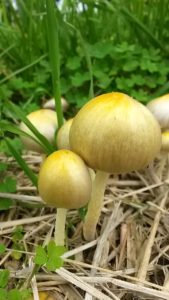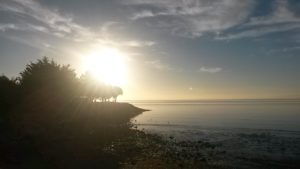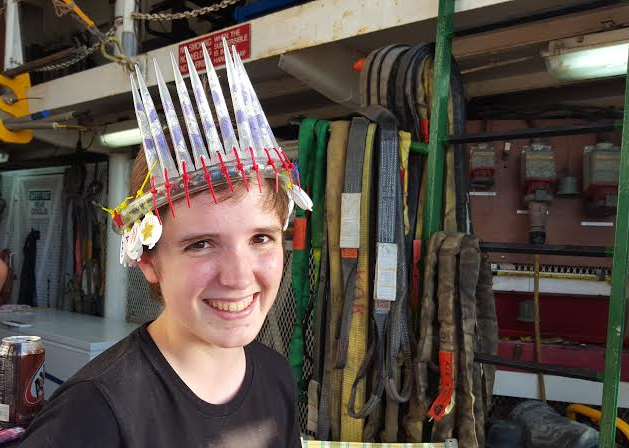Planting Seeds: Leah Newton ’19 at Literacy for Environmental Justice (LEJ) in San Francisco, California
Feb 28, 2017For my second co-op, I am working as an intern with a nonprofit organization called Literacy for Environmental Justice in southeast San Francisco. The work LEJ does ranges from activism (they were instrumental in shutting down an old PG&E power plant in Hunter’s Point) to job training for youth (they have a high school internship program called Bay Youth for the Environment in partnership with the California State Parks Foundation) to urban greening and habitat restoration (they run a native plant nursery aimed at repopulating remnant populations of San Francisco’s native ecosystems). LEJ is committed to serving the community of southeast San Francisco, namely the Bayview/Hunter’s Point district, which is a community heavily impacted by environmental racism and toxic waste.

A glassy pond at Candlestick Point.
My work over the course of my internship so far has primarily been centered around habitat restoration. One of LEJ’s current major projects is the restoration of Candlestick Point State Recreation Area, the first urban state park in California. This summer, six campsites will be installed in the park – only the second urban campground in the city of San Francisco. Many of my days have been spent at the park’s Sunrise Point, planting a variety of native plants from the prickly annual Phacelia distans to the hardy and fragrant yarrow.

Mushrooms at a planting site.
Time that is not spent putting plants in the ground is devoted to a host of associate tasks, including mulching, weeding, and caring for plants in the nursery. Sometimes we have school groups out – so far I’ve worked with one group of middle schoolers and two separate high school groups, out at Sunrise Point – and LEJ holds volunteer days twice a month. With the school groups, LEJ program staff emphasize the importance of providing a rewarding outdoor experience to youth in a district with a severe lack of open space. It’s a good feeling to be able to help offer this kind of experience to kids with minimal experience with, or exposure to, working with plants.
Many people pass through Candlestick while we work: families, people walking their dogs, a father racing his remote control car against the electric toy car his small son is driving. A lot of people stop to ask what we’re doing; some even recognize the plants we’re planting. After we explain – or sometimes just as they jog by – people often thank us for our work. It makes me hopeful that I’m contributing in some meaningful way to the health and happiness of this community I know so little about.
I don’t think I want to pursue restoration work as a career, but I’m glad to have this experience. Working in this capacity has reshaped the way I think about myself in relation to my environment, both human and ecological, and has prompted me to reflect on the ways in which we can – indeed, are obligated to – pursue equity throughout our society.

View of Candlestick Point, along my morning bike route.
A Glimpse of the Sea: Newton ’19 at Oregon State University’s College of Earth, Ocean and Atmospheric Sciences in Corvallis, Oregon
Jul 11, 2016I find it hard to believe that I’ve been working at Oregon State University’s College of Earth, Ocean, and Atmospheric Sciences for over a month now. The time has glided by noiseless as an albatross – you’ll understand that reference later – and left me feeling simultaneously as though I’ve barely started and as though I have never actually not been here.
I’m back in Corvallis now, after a few weeks at sea on a research vessel out of Honolulu. On the flight into Portland yesterday, my seatmate remarked at one point that “the quality of the work is absolutely and intrinsically decided by the quality of the people you work with,” an observation that perfectly echoes my feelings about being here. The group of people I work for is so completely fantastic that I’d hardly care if I was cleaning toilets so long as I was with them (I am, of course, very happy to be doing oceanography instead).

The lab group I’m working for is focused on phytoplankton research, and my duties on the cruise consisted primarily of filtering a whole lot of seawater from various locations and depths, a circumstance that led to my coronation as “filter queen.” Now that I’m back, I’ll be turning my hand to processing the samples we collected throughout the blue water/green water gradient we traversed on the cruise. It has been, and continues to be, absolutely amazing to have this first-hand experience of working in a real lab setting. I am so conscious of how incredible it is that, as a first year undergrad, I’ve ended up with such a wonderful situation working with such brilliant people.
I t’s quite a series of unlikely events that got me here. I didn’t expect to go to Antioch; I didn’t expect to study science; I didn’t expect to go anywhere except Turkey for my first co-op. But somehow, against all my expectations, I landed here, and I genuinely could not be more glad that I did.
t’s quite a series of unlikely events that got me here. I didn’t expect to go to Antioch; I didn’t expect to study science; I didn’t expect to go anywhere except Turkey for my first co-op. But somehow, against all my expectations, I landed here, and I genuinely could not be more glad that I did.
(If you’re interested in more of my thoughts and experiences working in oceanography, feel free to check out my personal blog, where I go into a lot more detail about this co-op.)



